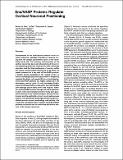Ena/VASP Proteins Regulate Cortical Neuronal Positioning
Author(s)
Goh, Keow Lin; Cai, Li; Cepko, Constance L.; Gertler, Frank
DownloadGertler_Ena VASP proteins.pdf (253.2Kb)
PUBLISHER_POLICY
Publisher Policy
Article is made available in accordance with the publisher's policy and may be subject to US copyright law. Please refer to the publisher's site for terms of use.
Terms of use
Metadata
Show full item recordAbstract
Development of the multilayered cerebral cortex involves extensive regulated migration of neurons arising from the deeper germinative layers of the mammalian brain [1]. The anatomy and formation of the cortical layers has been well characterized; however, the underlying molecular mechanisms that control the migration and the final positioning of neurons within the cortex remain poorly understood 2 and 3. Here, we report evidence for a key role of Ena/VASP proteins, a protein family implicated in the spatial control of actin assembly [4] and previously shown to negatively regulate fibroblast cell speeds [5], in cortical development. Ena/VASP proteins are highly expressed in the developing cortical plate in cells bordering Reelin-expressing Cajal-Retzius cells and in the intermediate zone through which newly born cells migrate. Inhibition of Ena/VASP function through retroviral injections in utero led to aberrant placement of early-born pyramidal neurons in the superficial layers of both the embryonic and the postnatal cortex in a cell-autonomous fashion. The abnormally placed pyramidal neurons exhibited grossly normal morphology and polarity. Our results are consistent with a model in which Ena/VASP proteins function in vivo to control the position of neurons in the mouse neocortex.
Date issued
2002-04Department
Massachusetts Institute of Technology. Department of BiologyJournal
Current Biology
Publisher
Elsevier
Citation
Goh, Keow Lin, Li Cai, Constance L. Cepko, and Frank B. Gertler. “Ena/VASP Proteins Regulate Cortical Neuronal Positioning.” Current Biology 12, no. 7 (April 2002): 565-569. Copyright © 2002 Elsevier Science Ltd.
Version: Final published version
ISSN
09609822
1879-0445